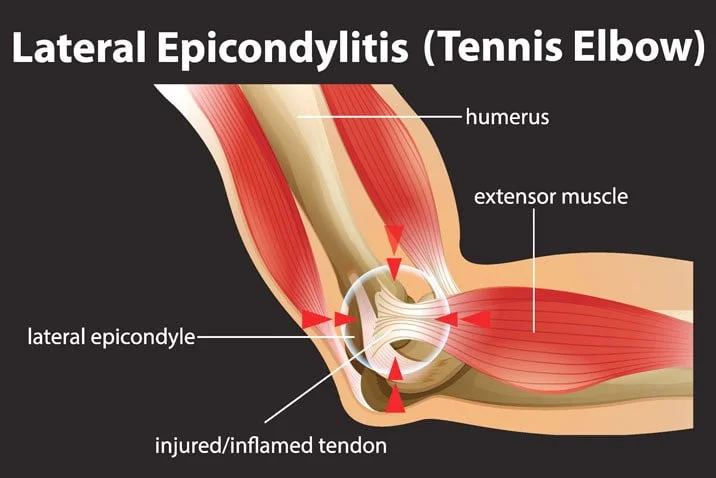Tennis elbow, medically known as lateral epicondylitis, is a painful condition caused by overuse or degeneration of the extensor tendons that attach to the lateral epicondyle — the bony bump on the outside of the elbow. The condition ranges from tendonitis (inflammation) to tendinosis (degenerative changes and microtears) and can cause weakness, pain with gripping, and difficulty with wrist extension. NCBI+1

Tennis elbow results from repetitive loading of the wrist extensor tendons. Common causes include:
Typical symptoms include:
See a clinician if pain limits daily activities, lasts more than a few weeks despite home care, or you suspect a tendon rupture (sudden sharp pain, palpable gap, marked weakness).
Diagnosis is usually clinical — history and exam maneuvers (like resisted wrist extension and the “middle finger test”). Imaging (ultrasound or MRI) is reserved for atypical cases, persistent symptoms, or to evaluate tendon tears. OrthoInfo
Most cases respond to conservative management over weeks to months:
PRP is an autologous blood product concentrated for platelets and growth factors, injected into the degenerative tendon area to enhance healing.
Bottom line from recent systematic reviews and RCTs:
Key nuances to consider:
Representative evidence citations: multiple RCTs and meta-analyses conclude: corticosteroids faster short-term relief; PRP yields better long-term functional outcomes and pain relief for many patients with lateral epicondylitis. PubMed+2PubMed+2
Surgery is an option for persistent, disabling lateral epicondylitis that does not improve after 6–12 months of comprehensive conservative care (including PT, bracing, injections as indicated). Surgical options include debridement of degenerated tendon tissue, open or arthroscopic release, and sometimes tendon repair or augmentation. Outcomes are generally good in appropriately selected patients, but recovery and rehab take time. OrthoInfo
What is Tennis Elbow (Lateral Epicondylitis)? Tennis elbow, medically known as lateral epicondylitis, is a painful condition caused by overuse or degeneration of the extensor tendons that attach to the lateral epicondyle — the bony bump on the outside of the elbow. The condition ranges from tendonitis (inflammation) to tendinosis (degenerative changes and microtears) and can cause weakness, pain with gripping, and difficulty with wrist extension.
Tennis elbow, medically known as lateral epicondylitis, is a painful condition caused by overuse or degeneration of the extensor tendons that attach to the lateral epicondyle — the bony bump on the outside of the elbow. The condition ranges from tendonitis (inflammation) to tendinosis (degenerative changes and microtears) and can cause weakness, pain with gripping, and difficulty with wrist extension. NCBI+1

Tennis elbow results from repetitive loading of the wrist extensor tendons. Common causes include:
Typical symptoms include:
See a clinician if pain limits daily activities, lasts more than a few weeks despite home care, or you suspect a tendon rupture (sudden sharp pain, palpable gap, marked weakness).
Diagnosis is usually clinical — history and exam maneuvers (like resisted wrist extension and the “middle finger test”). Imaging (ultrasound or MRI) is reserved for atypical cases, persistent symptoms, or to evaluate tendon tears. OrthoInfo
Most cases respond to conservative management over weeks to months:
PRP is an autologous blood product concentrated for platelets and growth factors, injected into the degenerative tendon area to enhance healing.
Bottom line from recent systematic reviews and RCTs:
Key nuances to consider:
Representative evidence citations: multiple RCTs and meta-analyses conclude: corticosteroids faster short-term relief; PRP yields better long-term functional outcomes and pain relief for many patients with lateral epicondylitis. PubMed+2PubMed+2
Surgery is an option for persistent, disabling lateral epicondylitis that does not improve after 6–12 months of comprehensive conservative care (including PT, bracing, injections as indicated). Surgical options include debridement of degenerated tendon tissue, open or arthroscopic release, and sometimes tendon repair or augmentation. Outcomes are generally good in appropriately selected patients, but recovery and rehab take time. OrthoInfo